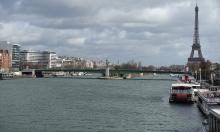Chinese protest against poorly constructed schools
Chinese police Tuesday dragged away more than 100 parents protesting the deaths of their children in poorly constructed schools that collapsed in last month's earthquake.

The parents, many holding pictures of their dead children, were pulled down the street away from a courthouse in Dujiangyan, a resort city northwest of the Sichuan provincial capital of Chengdu.
"Why?" some of them yelled. "Tell us something," they said as black-suited police wearing riot helmets yanked at them.
The parents had been kneeling in front of the courthouse yelling, "We want to sue." Their children attended a high school in Juyuan, near Dujiangyan, where 270 students died. The Southern Metropolis News quoted a rescuer as saying last month that rubble from the school showed that no steel reinforcing bars had been used in construction, only iron wire.
"The parents were here to give their report to the court," said one police officer who refused to give his name.
Calls to local police were not answered Tuesday.
Accusations that students died in the May 12 earthquake because of shoddy school construction have galvanized anger and grabbed the public's attention, and also worried the government.
President Hu Jintao and other top leaders have been shown repeatedly on state television visiting children in makeshift schools.
The government says the May 12 earthquake destroyed 7,000 classrooms.
Many parents have accused contractors of cutting corners when building the classrooms, resulting in schools that could not withstand the 7.9-magnitude quake. Pictures of collapsed schools surrounded by buildings still standing have fueled anger.
Tuesday's protest happened while Chinese leader Li Changchun, the country's fifth-ranked ruler, was touring other parts of the city. The official Xinhua News Agency said Li was checking heritage sites damaged in the earthquake.
An official from the foreign affairs office of the local government, Zao Ming, said "this is not a good place to do interviews. ... In a disaster like this, there will be a lot of opinions. The government will solve their problems."
There were several Japanese reporters at the courthouse. One witness who did not want to be identified said the police told the parents "the Japanese are reporting bad things about you."
An Associated Press reporter and two photographers covering the protest were forcibly dragged up the steps into the courthouse by police trying to prevent them from seeing the demonstration.
Foreign Ministry spokesman Qin Gang said Tuesday that the government had been unusually open about allowing journalists to report on the earthquake and its aftermath. He told a news conference in Beijing that the "principle of transparency and openness remains unchanged."
He said local authorities were making decisions based on the conditions in the disaster zone, though "they are not trying to block any news or to make difficulties for the reporters."
The confirmed death toll for China's worst disaster in three decades was raised Tuesday to 69,107, an increase of about 90 from the previous day, with more than 18,200 people still missing, the government said. The quake also left 5 million people homeless.
Meanwhile, Xinhua said authorities have delayed for two days a bid to divert water from a huge lake formed when the quake sent landslides tumbling into a river in northern Sichuan.
Water levels in the lake had been rising steadily and threatened to flood surrounding areas, prompting authorities to evacuate nearly 200,000 people already uprooted by the quake.
But Xinhua said with little rain forecast for the next several days, rescue workers were not likely to start draining off the water until Thursday. The work had been expected to start Tuesday.
Workers have already used heavy earth-moving equipment to dig a runoff channel to remove the water. The government is worried the newly formed lake could burst, sending a wall of water through a valley.
In an indication of how difficult rescue conditions are in parts of Sichuan, there is still no sign of a helicopter that crashed more than three days ago while ferrying survivors. Thousands of soldiers have combed remote mountains in search of the military helicopter.
The Russian-designed Mi-171 transport was carrying 19 people, 14 of them people injured in the quake, when it flew into fog and turbulence and crashed Saturday near the epicenter of the quake in the town of Wenchuan, state media reported.
Subscribe to Pravda.Ru Telegram channel, Facebook, RSS!




